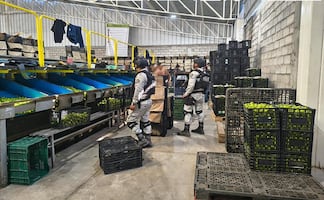Más Información

FGR investiga caja negra del Tren Interoceánico y concluye necropsias; despliega peritos en 13 especialidades

A 50 días del Plan Michoacán, detienen a 278 personas; realizan recorridos a empacadoras e industrias cítricas

Prueba piloto para afiliar a trabajadores de plataformas digitales aún no termina, explica IMSS; acciones continúan, dice

Detienen y vinculan a proceso Alejandro Baruc “N” en Uruapan, Michoacán; podría estar relacionado con el asesinato de Carlos Manzo

Emiten alerta en seis estados por robo de cilindro con gas cloro; advierten por alto nivel de toxicidad
Acitrón
is a candy made using the biznaga cactus , also known as Echinocactus Grandis . In Mexico , acitrón is essential for both savory and sweet dishes , including tamales and chiles en nogada .
Nevertheless, acitrón is now banned for its consumption since the biznaga cactus is endangered .
Acitrón
is made using biznaga pulp , which is boiled in water and then boiled again in syrup , nevertheless, the biznaga cactus was named as a protected species in 2005. The measure implemented by the SAGARPA limited its exploitation as a food source, nevertheless, it is still used to produce acitrón illegally.
The biznaga cactus can be found in deserts , mainly in the states Sonora and Chihuahua . Plants take between 14 and 40 years to grow but since this is not profitable for farmers, they opt for illegally cutting the few plants that still exist.
The origin of acitrón dates back to pre-colonial times and it was sold as a sweet in the Tlatelolco market . After the Spanish invasion , cane sugar was used to candy the cactus and its production was mainly carried out at convents .
And although acitrón is now banned , there are many other options to substitute this candy . In 2011, students from the Claustro de Sor Juana university experimented with candied fruits and vegetables and incorporated them into traditional dishes and found that one of the best options was candied yam .
Other sustainable options to substitute acitrón are candied xoconostle and papaya , as well as quince and ate .
gm
Noticias según tus intereses
[Publicidad]
[Publicidad]









